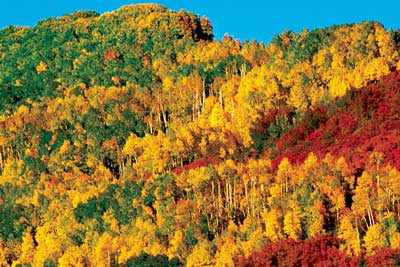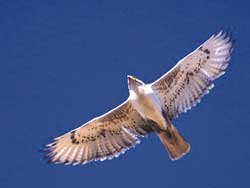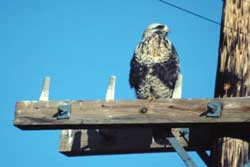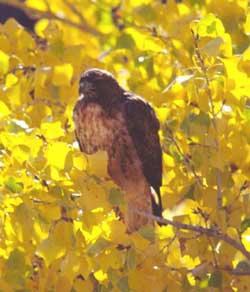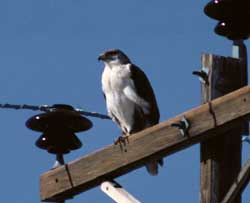As the climate of summer shifts from warming winds to the cold blasts of Arctic air, other telltale signs - golden aspens, burnt oakbrush and sienna-colored wild roses -indicate this seasonal passage. But these northern winds bring more than just chilling temperatures into Canyon Country; they bring a buteo from the Arctic tundra – the rough-legged hawk.
Rough leggeds get their name from their feathered legs that provide additional insulation in cold climates. Their scientific name Buteo lagopus reveals several characteristics of these redtail-sized hawks. First is the genus name, which places these birds in the group of soaring hawks, known as buteos. Most buteos have large broad wings designed for extended periods of soaring over open country in search of prey. Secondly is the species name, lagopus, meaning “hares foot,” describing their feathered legs.
On their Arctic summering grounds, rough-leggeds ingest a steady diet of lemmings, voles, insects, small birds, and carrion. But as those tundra areas become blanketed with winter snows, these hawks head south to winter throughout the lower 48 states in habitats reminiscent of their arctic breeding grounds.
Good areas to observe wintering rough-leggeds are in open areas around the Cisco and Green River deserts, agricultural and fallow fields in the Moab Valley or in La Sal or pastures east of Monticello. Look for birds perched on phone poles, fence lines, on the ground, or in flight.
Rough leggeds come in two color plumages – light and dark. Light morph birds bear distinctive dark patches at their wrists called carpal patches, along with a light colored head and dark bellyband. When viewed while perched, this bellyband resembles a dark vest enclosing the belly but exposing the lighter and lightly streaked plumage on the chest and head.
Dark morph birds, more common in the eastern United States, may obscure their telltale dark carpal patch, but both morphs have a white tail with a large dark band near the tip.
Several other field marks may help to identify these birds. While soaring, the rough-leggeds hold their wings upward at an angle at the tips. This slight dihedral pattern may be reminiscent of how turkey vultures hold their wings, but the vultures have long departed for warmer climates. Another mark is the pale upperwing patch on the juveniles, a sort of semi-translucent like feathering, on the outer ends of the wings. Visible when the birds are soaring, this patch may also be seen while the birds hover in search of prey. In fact, this hovering flight pattern is another good clue that points to the rough-leggeds’ identification from a distance - rough-leggeds spend a fair amount of time hovering while hunting.
In addition to the rough-leggeds and red-tailed hawks, the ferruginous hawk is another buteo that may be observed during the year in southeastern Utah. These long-winged birds nest in juniper trees, on hillsides, cliff faces or small rock spires in the area. Some breeding birds may remain year-round while others migrate south. Of course, birds from other locations may migrate to the Moab area where they also dine on the area’s steady diet of small rodents and rabbits.
Ferruginous is a term that describes the burnt-reddish coloring of the bird’s back, wings and leg feathers. And like the rough-leggeds, the “ferrug”, as birders like to call them, also comes in light and dark color morphs. Although these “morphs” have been called “phases” in the past, that term indicates the birds switch between the light and dark forms which is incorrect. It’s either or for these species throughout their lifetimes.
